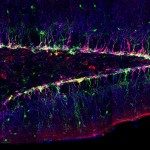Link to Pubmed [PMID] – 16598259
Nature 2006 Apr;440(7085):803-7
Breaking left-right symmetry in Bilateria embryos is a major event in body plan organization that leads to polarized adult morphology, directional organ looping, and heart and brain function. However, the molecular nature of the determinant(s) responsible for the invariant orientation of the left-right axis (situs choice) remains largely unknown. Mutations producing a complete reversal of left-right asymmetry (situs inversus) are instrumental for identifying mechanisms controlling handedness, yet only one such mutation has been found in mice (inversin) and snails. Here we identify the conserved type ID unconventional myosin 31DF gene (Myo31DF) as a unique situs inversus locus in Drosophila. Myo31DF mutations reverse the dextral looping of genitalia, a prominent left-right marker in adult flies. Genetic mosaic analysis pinpoints the A8 segment of the genital disc as a left-right organizer and reveals an anterior-posterior compartmentalization of Myo31DF function that directs dextral development and represses a sinistral default state. As expected of a determinant, Myo31DF has a trigger-like function and is expressed symmetrically in the organizer, and its symmetrical overexpression does not impair left-right asymmetry. Thus Myo31DF is a dextral gene with actin-based motor activity controlling situs choice. Like mouse inversin, Myo31DF interacts and colocalizes with beta-catenin, suggesting that situs inversus genes can direct left-right development through the adherens junction.

